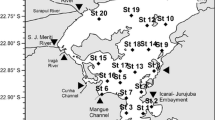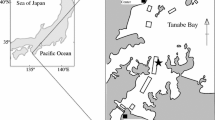Abstract
Lipopolysaccharides (LPS), added as whole bacteria to estuarine sediments, were extracted efficiently by both trichloroacetic acid (TCA) and phenol-water (PW). Amounts of recovered LPS were measured indirectly by analyses for ketodeoxyoctonate (KDO), β-hydroxymyristic acid, immunodominant sugars and anticomplementary (AC) activity towards human complement. TCA was judged to be better than PW for routine extraction of sediments because, although it yielded 10–20% less LPS, it avoided contamination with non-LPS, high-molecular weight material with high AC activity. In sediment samples taken as cores from estuarine beaches, the concentration of endogenous LPS diminished rapidly with depth below the topmost 1 cm. KDO disappeared more rapidly with depth than AC activity. When known LPS was incubated with estuarine beach mud at 20–22°C for 3 weeks there was extensive biodegradation of both the lipid and polysaccharide components, the latter more rapidly. LPS-degrading bacteria were isolated.
Similar content being viewed by others
References
Boivin, A., Mesrobeanu, J. et Mesrobeanu, L. 1933. Technique pour la préparation des polyosides microbiens specifiques. — Compt. Rend. Soc. Biol. 113: 490–492.
Ellwood, D. C. 1970. The distribution of 2-keto-3-deoxyoctonic acid in bacterial walls. —J. Gen. Microbiol. 60: 373–381.
Evans, T. M., Schillinger, J. E. and Stuart, D. G. 1978. Rapid determination of bacteriological water quality by using Limulus lysate. — Appl. Environ. Microbiol. 35: 376–382.
Galanos, C., Rietschel, E. Th., Lüderitz, O. and Westphal, O. 1971. Interaction of lipopolysaccharides and lipid A with complement. — Eur. J. Biochem. 19: 143–152.
Galanos, C., and Lüderitz, O. 1976. The role of the physical state of lipopolysaccharide in the interaction with complement. — Eur. J. Biochem. 65: 403–408.
Inai, S., Kazuyoshi, N., Ebisu, S., Keÿino, K., Kotani, S. and Nisaki, A. 1976. Activation of the alternative complement pathway by water insoluble glucans of Streptococcus mutans; the relation between their chemical structures and activating potencies. — J. Immunol. 117: 1256–1260.
Jorgensen, J. M., Lee, J. C. and Pahren, H. R. 1976. Rapid detection of bacterial endotoxins in drinking water and renovated waste water. — Appl. Environ. Microbiol. 32: 347–351.
Kates, M. 1972. Isolation, analysis and identification of lipids. p. 446–469. In: Techniques in lipidology. — North Holland Press, Amsterdam.
Keleti, G. and Lederer, W. E. 1974. Handbook of micromethods for the biological sciences. — Van Nostrand Reinhold, New York.
Neter, E. 1956. Bacterial haemagglutination and haemolysis. — Bacteriol. Rev. 20: 166–171.
Rheinheimer, G. 1974. p. 35. In: Aquatic microbiology — John Wiley and Sons, New York.
Rietschel, E. Th., Galanos, C. and Lüderitz, O. 1975. Structure, endotoxicity, immunogenicity of the lipid A component of bacterial lipopolysaccharides. p. 307–314. In D. Schlessinger (ed). Microbiology. — American Society for Microbiology, Washington.
Saddler, J. N. and Wardlaw, A. C. 1978. Superiority of human complement for assaying bacterial lipopolysaccharides by their anticomplementary activity. — Experientia 34: 1227–1228.
Thatcher, R. C. and Weaver, T. L. 1974. Simplified method for the preparation of silica media. — Appl. Microbiol. 28: 887–888.
Voets, J. P., Vandamme, E. J. and De Maerteleine, E. 1973. Biodegradation of microbial lipopolysaccharides. — Experientia 29: 730–731.
Waravdekar, V. S. and Saslaw, L. D. 1959. A sensitive colorimetric method for the estimation of 2-deoxy sugars with the use of the malonaldehyde-thiobarbituric acid reaction. — J. Biol. Chen. 234: 1945–1950.
Westphal, O., Lüderitz, O. und Bister, F. 1952. Über bakterielle Reizstoffe 1. mit Reindarstellung eines Polysaccharid-Pyrogens aus Bacterium coli. — Z. Naturforsch. 7b: 537–548.
Winkelstein, J. A. and Tomasz, A. 1978. Activation of the alternative complement pathway by Pneumococcal cell wall teichoic acid. — J. Immunol. 120: 174–178.
ZoBell, C. E. and Upham, H. C. 1944. A list of marine bacteria including descriptions of sixty new species. — Bull. Scripps Inst. Oceanogr. 5: 239–292.
Author information
Authors and Affiliations
Rights and permissions
About this article
Cite this article
Saddler, J.N., Wardlaw, A.C. Extraction, distribution and biodegradation of bacterial lipopolysaccharides in estuarine sediments. Antonie van Leeuwenhoek 46, 27–39 (1980). https://doi.org/10.1007/BF00422226
Received:
Issue Date:
DOI: https://doi.org/10.1007/BF00422226




